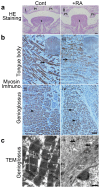Implications of the Wnt5a/CaMKII pathway in retinoic acid-induced myogenic tongue abnormalities of developing mice
- PMID: 25124193
- PMCID: PMC4133706
- DOI: 10.1038/srep06082
Implications of the Wnt5a/CaMKII pathway in retinoic acid-induced myogenic tongue abnormalities of developing mice
Abstract
Although proper tongue development is relevant to other structures in the craniofacial region, the molecular details of muscle development in tongue remain poorly understood. Here, we report that pregnant mice treated with retinoic acid (+RA) produce embryos with tongue malformation and a cleft palate. Histological analyses revealed that at E14.5, the tongues of +RA fetuses failed to descend and flatten. Ultrastructural analysis showed that at perinatal stage E18.5, the myofilaments failed to form normal structures of sarcomeres, and arranged disorderly in the genioglossus. The proliferation and levels of myogenic determination markers (Myf5 and MyoD) and myosin in the genioglossus were profoundly reduced. Wnt5a and Camk2d expressions were down-regulated, while levels of Tbx1, Ror2, and PKCδ were up-regulated in the tongues of +RA fetuses. In mock- and Wnt5a-transfected C2C12 (Wnt5a-C2C12) cells, Wnt5a overexpression impaired proliferation, and maintained Myf5 at a relative high level after RA treatment. Furthermore, Wnt5a overexpression positively correlated with levels of Camk2d and Ror2 in C2C12 cells after RA exposure. These data support the hypothesis that the Wnt5a/CaMKII pathway is directly involved in RA-induced hypoplasia and disorder of tongue muscles.
Figures




References
-
- Hall J. G. Importance of muscle movement for normal craniofacial development. J Craniofac Surg. 21, 1336–1338 (2010). - PubMed
-
- Yamane A. et al. Expression of myogenic regulatory factors during the development of mouse tongue striated muscle. Arch Oral Biol. 45, 71–78 (2000). - PubMed
-
- Dalrymple K. R., Prigozy T. I., Mayo M., Kedes L. & Shuler C. F. Murine tongue muscle displays a distinct developmental profile of MRF and contractile gene expression. Int J Dev Biol. 43, 27–37 (1999). - PubMed
-
- Mok G. F. & Sweetman D. Many routes to the same destination: lessons from skeletal muscle development. Reproduction. 141, 301–312 (2011). - PubMed
Publication types
MeSH terms
Substances
LinkOut - more resources
Full Text Sources
Other Literature Sources
Molecular Biology Databases
Miscellaneous

